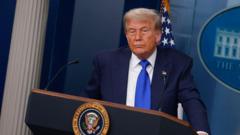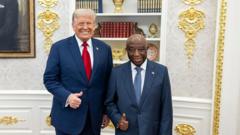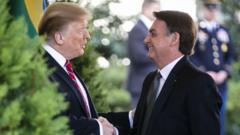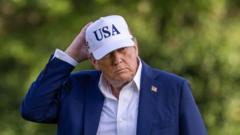Canada's election is in motion as voters across the country select their representatives, crucial for the nation's leadership direction amidst external pressures. Recent polling data indicates a resurgence of support for the Liberal Party led by Prime Minister Mark Carney, following the resignation of Justin Trudeau and Trump's aggressive economic stance against Canada. This sudden shift contrasts sharply with earlier predictions favoring the Conservative Party, now led by Pierre Poilievre.
Canada's Election: A Race Altered by Trump’s Policies

Canada's Election: A Race Altered by Trump’s Policies
The Canadian federal election becomes pivotal as President Trump's economic actions reshape dynamics, with the Liberal Party gaining momentum.
As voting unfolds, Canadian citizens face a complex political landscape shaped by Trump's administration, whose tariffs and controversial remarks about Canadian sovereignty have necessitated an urgent focus on national identity and economic resilience. The election involves not only the two primary parties but also three smaller groups, raising the stakes as the country navigates economic challenges.
Carney, taking charge as the Liberal leader, is positioning himself as an anti-Trump figure, while Poilievre’s alignment with Trump’s populism raises concerns among voters wary of similar ideologies. With critical issues like soaring housing costs and economic stability, both leaders offer competing visions that reflect Canada’s divided electorate. As the countdown to results commences, the outcomes will undoubtedly shape Canada’s response to external threats and define its domestic agenda for years to come.
There are numerous overarching narratives influencing voter sentiment, notably the looming challenges of Trump's tariffs on key sectors and economic discontent. Voters express a mix of frustration with the previous administration alongside concerns that support any party resembles a rejection of their values. From housing crises impacting urban centers to national sovereignty fears, the election encapsulates a consequential moment for the Canadian populace, forecasting drastic changes ahead.
With polls closing throughout the evening and results anticipated late Monday, the nation holds its breath. The political climate reveals deep divisions, but it also signals an awakening of civic engagement as Canadians contemplate not just their leaders but their collective identity in a landscape increasingly influenced by foreign policy.
Carney, taking charge as the Liberal leader, is positioning himself as an anti-Trump figure, while Poilievre’s alignment with Trump’s populism raises concerns among voters wary of similar ideologies. With critical issues like soaring housing costs and economic stability, both leaders offer competing visions that reflect Canada’s divided electorate. As the countdown to results commences, the outcomes will undoubtedly shape Canada’s response to external threats and define its domestic agenda for years to come.
There are numerous overarching narratives influencing voter sentiment, notably the looming challenges of Trump's tariffs on key sectors and economic discontent. Voters express a mix of frustration with the previous administration alongside concerns that support any party resembles a rejection of their values. From housing crises impacting urban centers to national sovereignty fears, the election encapsulates a consequential moment for the Canadian populace, forecasting drastic changes ahead.
With polls closing throughout the evening and results anticipated late Monday, the nation holds its breath. The political climate reveals deep divisions, but it also signals an awakening of civic engagement as Canadians contemplate not just their leaders but their collective identity in a landscape increasingly influenced by foreign policy.




















